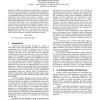54 search results - page 5 / 11 » Multi-Threshold Asynchronous Circuit Design for Ultra-Low Po... |
ISVLSI
2006
IEEE
14 years 1 months ago
2006
IEEE
Thermal management is becoming increasingly important in circuit designs with high power density. Circuits that overheat beyond specified operating conditions may suffer timing f...
DAC
2007
ACM
14 years 8 months ago
2007
ACM
Asynchronous circuits are increasingly attractive as low power or high-performance replacements to synchronous designs. A key part of these circuits are asynchronous micropipeline...
ISCAS
2005
IEEE
14 years 28 days ago
2005
IEEE
: Asynchronous circuits are often presented as a means of achieving low power operation. We investigate their suitability for low-energy applications, where long battery life and d...
CHES
2003
Springer
14 years 18 days ago
2003
Springer
Abstract. Balanced asynchronous circuits have been touted as a superior replacement for conventional synchronous circuits. To assess these claims, we have designed, manufactured an...
ASYNC
1999
IEEE
13 years 11 months ago
1999
IEEE
Relative Timing is introduced as an informal method for aggressive asynchronous design. It is demonstrated on three example circuits (C-Element, FIFO, and RAPPID Tag Unit), facili...

